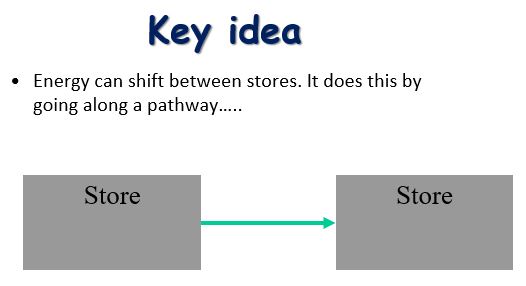Revision of Energy stores and transfers for GCSE Physics/Combined Science.
Energy stores
There are 8 energy stores where energy can be ‘kept’:
– chemical store (in a chemical reaction e.g. fuel + oxygen)
– kinetic store (in a moving object)
– gravitational store (due to the position of an object in a gravitational field)
– elastic store (e.g. in a stretched or compressed spring)
– thermal store (in a warm object)
– magnetic store (in two separated magnets that are attracting, or repelling)
– electrostatic store (in two separated electric charges that are attracting, or repelling)
– nuclear store (released through radioactive decay, fission or fusion.
Key definition – what is a system?
A system is an object or group of objects.

Examples
An object projected upwards: (e.g. ball thrown upwards):
Kinetic store of ball → Gravitational potential store of ball
A moving object hitting an obstacle: (e.g. car hitting a traffic cone):
Kinetic store of moving object → Kinetic store of obstacle
An object accelerated by a constant force: (e.g. skydiver accelerated by their
weight):
Gravitational potential store of skydiver → Kinetic store of skydiver
A vehicle slowing down (e.g. car applying brakes):
Kinetic store of car → Thermal store of brake pads.
Bringing water to boil in an electrical kettle:
Thermal store of element → Thermal store of water in kettle
Energy transfers
There are four pathways along which energy is transferred from one store to another:
– Heating
– Electrical
– Radiation (including light, all electromagnetic waves and sound).
– Mechanical
Quick Check 1
Example – energy stores and transfers in a roller coater ride
As a roller coaster climbs to it’s highest point, it transfers energy from the electrical supply to a gravitational store. There is a motor doing mechanical work on the roller coaster, applying a force to make it move up. As it goes over the highest point and starts to move downwards, energy is rapidly shifted from this gravitational store to a kinetic store. The force of gravity is doing mechanical work on the roller coaster, pulling it down the slope.
Energy calculations
You need to be able to calculate the energy transferred, using the following equations:
In heating
(ΔE = mcΔθ)
Change in thermal energy = mass x specific heat capacity x change in temperature
Mechanical work done by forces
(W = Fd)
Work done = Force x distance
Electrical work done when a current flows
(W = IVt)
Work done = Current x potential difference x time
Quick Check 2Kinetic Energy
The equation for kinetic energy:
Kinetic energy = ½ x mass x velocity2
EK = Kinetic energy measured in joules (J)
m = mass measured in kilograms (kg)
v = velocity measured in metres per second (m/s)
Elastic Potential Energy
The equation for elastic potential energy is:
Ee= 0.5 x k x e2
Elastic potential energy = 0.5 x spring constant x extension2
Ee = Elastic potential energy (J) k = Spring constant (N/m) e = extension (m)
Quick Check 4Thermal Energy
The equation for change in thermal energy is:
ΔE = m x c x Δθ
Change in thermal energy = mass x specific heat capacity x change in temperature
ΔE = Change in thermal energy (J); m = Mass (kg); c = Specific heat capacity (J/kgoC)
Δθ = Change in temperature (oC)
The specific heat capacity of a substance is the amount of energy required to raise the temperature of one kilogram of the substance by one degree Celsius.
Quick Check 5Power
Power is defined as the rate at which energy is transferred or the rate at which work is done.
The equation for power is:
P = E ÷ t
Power = Energy transferred ÷ time
P = Power (W); E = Energy transferred (J); t = time (s);
The equation for power can also be written:
P = W ÷ t
Power = Work done ÷ time
P = Power (W) W = Work done (J); t = time (s)
Watt is the unit of Power!? The question that answers itself.
An energy transfer of 1 joule per second is equal to a power of 1 watt.
Quick Check 6Conservation of Energy
Energy can be transferred usefully, stored or dissipated, but energy cannot be
created or destroyed.
Sometimes energy is dissipated, so that it is stored in less useful ways. This energy
is often described as being ‘wasted’.
Because energy cannot be lost: Total energy = useful energy + wasted energy
Unwanted energy transfers can be reduced by a range of methods, for example
through lubrication in car engines and the use of thermal insulation in houses.
The higher the thermal conductivity of a material the higher the rate of energy transfer by conduction across the material. The rate of cooling of a building is affected by the thickness and thermal conductivity of its walls.



